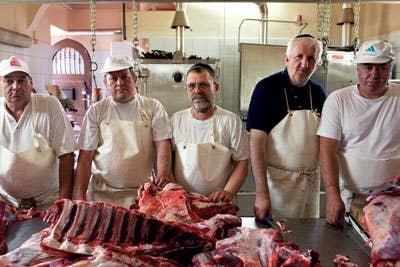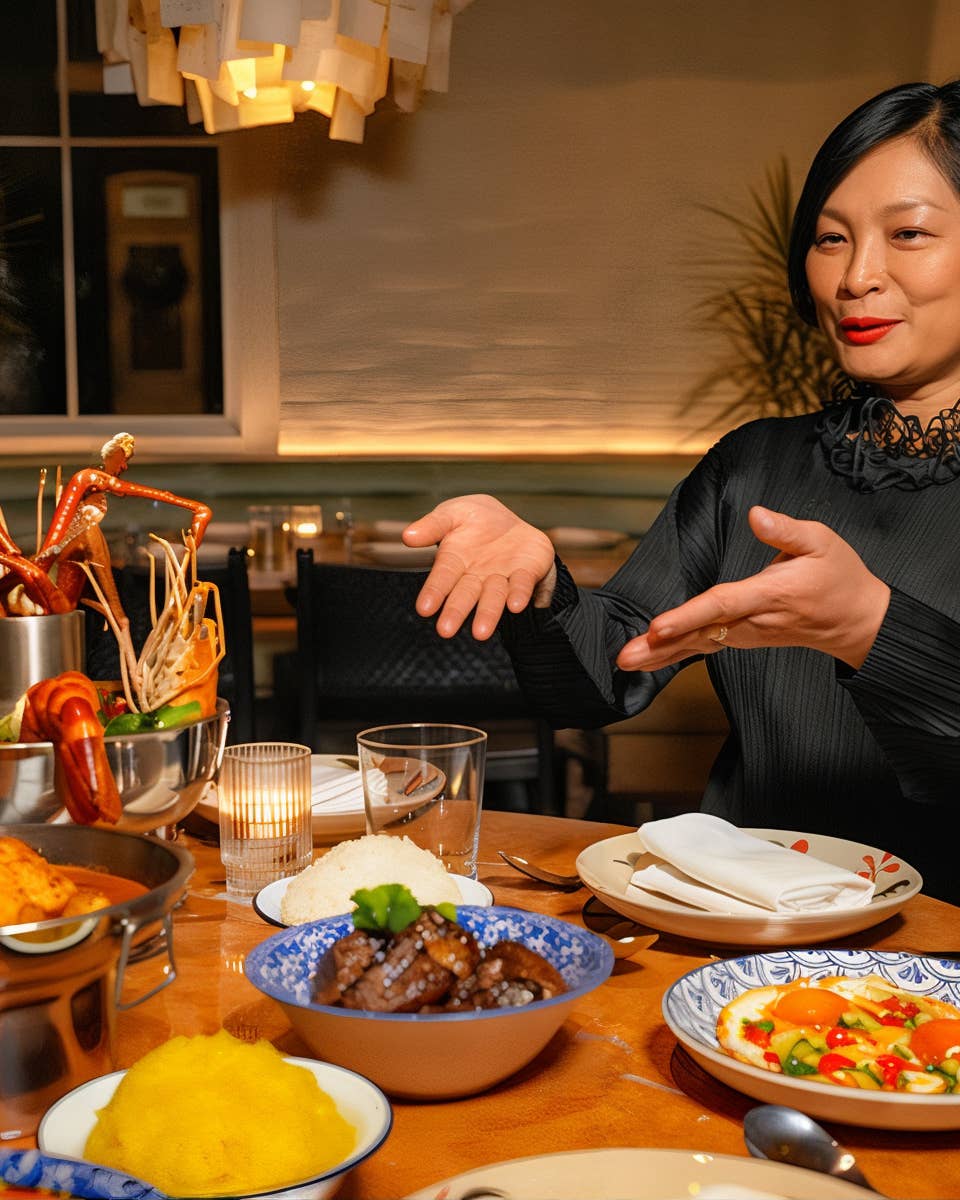
Roots of the Deli
A visit to eastern Europe reveals the origins of the cured and smoked meats, matzo balls, pickles, and other beloved staples of Jewish delicatessens around the world.
Growing up in Toronto, my knowledge of Jewish delicatessens extended no further than Yitz's Delicatessen, my family's once-a-week staple. Yitz's was our haven of oniony matzo ball soup (see Recipe: Matzo Balls and Goose Soup), briny coleslaw (see Recipe: Coleslaw), and towering corned beef sandwiches; a temple of worn Formica tables, surly waitresses, and hanging salamis. The dishes I ate there became my comfort food, and as I grew older, I started seeking out other Jewish delis wherever I went: Schwartz's and Snowdon in Montreal (where I learned to appreciate the glories of smoked meat); Rascal House in Miami Beach (baskets of sticky Danish); Katz's and Carnegie and 2nd Ave Deli in New York (Pastrami! Knishes!). By the time I finished writing the book Save the Deli, my battle cry for preserving these timepieces, I'd visited close to two hundred Jewish delis across North America, with stops in Belgium, France, and the UK. I'd become the deli guy, the expert people came to with questions about everything from kreplach to corned beef.
But for all my knowledge of Jewish delis, the roots of the foods served there remained a mystery to me. I'd learned that the word delicatessen derives from German and French and loosely translates as "delicious things to eat." And I knew that when they began appearing in New York and other North American cities in the 1870s, Jewish delicatessens were little more than bare-bones kosher butcher shops offering sausages and cured meats. But as the American Jewish experience evolved away from that of eastern Europe's, so did the Jewish delicatessen's menu. Its flavors assimilated, and it turned into an American sandwich shop with a greatest-hits collection of Yiddish home-style staples: chopped liver, knishes (see Recipe: Potato Knish), matzo ball soup.
A few years ago, I visited Krakow, Poland, to start seeking out the roots of those foods. Once a major center of European Jewish spiritual life, Krakow's Jewish population now numbers just a few hundred. The city's historic Jewish quarter is largely supported by tourism, and while some restaurants, like the estimable Klezmer Hois and Alef, serve up decent jellied carp and beef kreplach dumplings that any deli lover will recognize, others traffic in nostalgia and stereotypes; how could I trust the food at an eatery with a gift store selling Hasidic figurines with hooked noses?
There were once millions of Ashkenazi Jewish kitchens in eastern Europe. The foods of the shtetls were regional, taking on local flavors, and when European Jews came to America, that variety characterized the delicatessens they opened. You got pastrami at Romanian delicatessens, frankfurters at German ones, and blintzes from the Russians. The delis were all Jewish, but their regional roots were proudly on display.
The problem with researching these roots in eastern Europe is that there aren't many Jews nowadays. The countries I visited on my last research trip are no exception; Romania has fewer than 9,000 Jews (just one percent of its pre—World War II total), and while Hungary's population of 80,000 is the last remaining stronghold of Jewish life in the region, it's a fraction of what it once was. But I also have a personal connection to these countries: Romania was where my grandfather was born, and is the country associated with pastrami, spiced meats, and passionate Jewish carnivores. And Hungary was the land of my grandmother, with its soul-warming stews and baked goods that inspired delicatessens in America and beyond. What were Jewish cooks preparing over there, in these countries' capital cities, Bucharest and Budapest, respectively, and how were those foods related to the deli fare we all know and love? I didn't expect to find the checkered linoleum and big sandwiches of my childhood deli, but I hoped to find some of its original flavor and inspiration.
In the sunny kitchen of the Bucharest Jewish Home for the Aged, cook Mihaela Alupoaie is preparing Friday night's Shabbat dinner for the center's residents and others in the Jewish community. Hers is the city's only public kosher kitchen. Out of the oven come gorgeous loaves of challah bread (see Recipe: Challah Bread), their dough soft and sweet, with a crisp crust. "The three main ingredients—air, earth, and water—are symbolic," says Mihaela, brushing her black hair from her face. "When you braid the three strands of dough, you tie them all together."
Because budgets are tight, bringing in prepared kosher food from abroad is impossible, so everything in Mihaela's kitchen is made from scratch. In the summer, fruit is boiled down into jams and compotes, which go into sweets year-round. In the basement of the facility there are shelves stacked with glass jars of homemade pickles—garlic-laden kosher dills, lemony artichokes, horseradish, and green tomatoes—that she serves with her meals.
Later that night, about 75 people sit down to the weekly feast in an airy auditorium at the nearby Jewish Community Center. Children gather around for the blessings over the candles, wine, and bread, as everyone noshes on the creamy chopped chicken liver Mihaela piped into the whites of hardboiled eggs (see Recipe: Chicken Liver-Stuffed Eggs). I sit with Ghizella Steiner-Ionescu and Suzy Stonescu, two talkative ladies of a certain age who regale me with tales of the Jewish food scene in Bucharest before the war. They tell me that along Văcăreşti Street, the community's main thoroughfare, there were dozens of bakeries, butchers, and grill houses, where skirt steaks and beef mititei (grilled kebab-style patties) were cooked over charcoal. Though none survived the war, I realize that these foods eventually found their way onto deli menus and inspired other Jewish restaurants in the United States, like Sammy's Roumanian Steakhouse in New York and similar steak houses in other cities (see Article: Deli Diaspora).
I ask about pastrami, Romania's greatest contribution to the Jewish delicatessen. Not so much a specific dish but a method of pickling, spicing, and smoking meat that originated with the Turks, pastrama, in various dishes, is still available in Romania, though none of them resemble the juicy, hand-carved, peppery navels and briskets famous at North American delis like Katz's and Langer's. Nowadays, you mostly get salted, dried beef or brined mutton. Mrs. Steiner-Ionescu and Mrs. Stonescu remember five or six pastrami places in Bucharest that mostly used duck or goose breast, though occasionally beef. The meat was cured and served cold as an appetizer—never steamed and in a sandwich; that transformation occurred in America. (See Article: Meats of the Deli.) It had been decades since the flavors of duck pastrami had graced their lips, the memories fading with the surviving generation.
"It's strange," Fernando Klabin, my guide in Bucharest, said the next day. "It's as though history was erased. The Jews never existed." In the yard of Klabin's small cottage an hour outside of Bucharest, his friend Silvia Weiss is laying out dishes on a makeshift table. Out comes a tartly sweet vinegar coleslaw, a dill-inflected mushroom salad, a tray of bite-size potato knishes she'd baked that morning. We eat sarmale—finger-size cabbage rolls filled with ground beef and sauteed onions (see Recipe: Stuffed Cabbage)--and each roll disappears in two bites, leaving only the sweet aftertaste of the paprika-laced jus. As we sit around after the meal, it hits me that it's nothing short of a miracle that these foods, these traditions, have survived.
Of all the Jewish communities of eastern Europe, Budapest's is a beacon of light. There's a thriving Jewish quarter in the 7th district, where bakeries like Frolich and Cafe Noe serve strong espresso and flodni, a dense triple-layer pastry with walnuts, poppy seeds, and apple filling that's the caloric totem of Hungarian Jewish cooking (see Recipe: Apple, Walnut, and Poppy Seed Pastry). Amid centuries-old synagogues and art deco buildings pockmarked with bullet holes from the war, I encounter restaurants serving beautiful versions of beloved deli staples: Cari Mama, a bakery and pizzeria, is known for cinnamon, chocolate, and nut rugelach (see Recipe: Cinnamon, Apricot, and Walnut Pastries) that disappear within hours of the shop's opening each morning.
Across the street, in a courtyard containing the Orthodox synagogue, is a restaurant called Hanna. Founded after the war as a soup kitchen for impoverished survivors of the Holocaust, it's now a community-owned center for Yiddish kosher cooking where you can get everything from matzo balls and kugel to beef goulash. With its wainscoting and chandeliers, it feels partly like a house of worship and partly like the legendary New York kosher restaurant Ratner's, complete with sarcastic waiters in tuxedo vests, and young boys in oversize black hats and long side curls, learning the art of kosher supervision.
Down a covered passageway is the Orthodox community's kosher butcher, where cuts of beef, chicken, turkey, duck, and goose are brined in kosher salt and transformed into salamis, knockwursts, hot dogs, kolbasz garlic sausages, and bolognas that dry in the open air. Once upon a time, Jewish delis in America all looked like this: places to get your meats, fresh and cured, straight from the butcher's blade and the smoker. The salamis are fiery, coarse, and downright intense. In America's delis you find one type of kosher salami. Here, in Budapest, you can get dozens.
The city's Jewish restaurant scene boasts a refined side, too, which I experienced at Fulemule, a popular place run by Andras Singer. On the day I visited, Singer explained to me how Jewish food culture had changed over the years. He, for example, grew up in a house where his Holocaust-survivor parents shunned Judaism. The only thing that remained of their culture was the food. His mother served cholent (a slow-cooked meat and bean stew) nearly every Saturday, but often with pork (see Recipe: Beef Stew). "They left the religion behind," says Singer, "but kept the food. This is how it was. Until the 1990s, Jewish life was very quiet."
With democracy came cultural exploration and a newfound sense of Jewish pride. Singer opened his restaurant in 2000, with a focus on updated versions of Jewish classics. He serves half a dozen variations on cholent, a dish that, like matzo ball soup, is eaten all over Hungary by Jews and non-Jews alike. He's also fond of goose, once the principal protein of eastern European Jewish cooking but practically nonexistent in American Jewish kitchens. Singer's matzo balls, served in a dark goose broth, are made from crushed whole sheets of matzo mixed with goose fat, egg, and a touch of ginger, lending a lively zing. Every other matzo ball I'd ever eaten originated with packaged matzo meal. Crumbling the matzo by hand, a timeworn method abandoned in America, turns each bite into a surprise of random textures.
A Jewish food revival was a plot point I hadn't expected to discover in Budapest, and it made me think of deli fare in an entirely new light. Back home, Jewish food is frozen in the past: at best, it's the homemade classics; at worst, it's processed corned beef, overly refined "rye bread," and packaged soup mix. But here the cuisine is exciting, dynamic, and utterly refined. I encountered restaurant owners, bakers, food writers, and bloggers who have been breathing new life into dishes that nearly disappeared during Communism.
One night, in the tiny apartment of food blogger Eszter Bodrogi, I watch as she bastes goose liver with rendered fat and sweet paprika until the lobes sizzle and brown (see Recipe: Paprika Foie Gras on Toast). Since 2007, Bodrogi has been chronicling her adventures in kosher cooking on her blog, Spice and Soul. Though initially worried that a Jewish food blog would attract anti-Semitic comments (the far right is resurgent in Hungary), the somewhat shy Eszter now courts 3,000 daily visits online, to a fan base that is largely not Jewish. "People connected with me on a personal level," she says, as she slices the liver and lays it on bread. "The food helped humanize Jews in their eyes."
She hands me a plate. For liver lovers it's sheer nirvana, at once melty and silken. It's this elegant face of Jewish cooking that has largely vanished in North America. At a deli in New York, you'll get a scoop of delicious chopped chicken liver, but never something this gorgeous, this fatty, this fresh and decadent. Never goose.
The next night, at the apartment of Miklos Maloschik and his wife, Rachel Raj, tradition once again meets Hungary's new Jewish culinary vanguard. Twenty-nine-year-old Raj (pronounced Ray) is Hungary's equivalent of her American counterpart: a high-octane food television host who had a show on Hungary's food channel called Rachel Asztala, or Rachel's Table. The couple own and operate the hip bakeries Cafe Noe and Bulldog, both built on the success of Rachel's flodni (reputed to be the best in town).
In the kitchen, Miklos doles out shots of palinka, homemade fruit brandy, the first of many on this long, spirited evening. The table fills with a mix of foods, some familiar to Jewish deli lovers (salmon gefilte fish, potato kugel, pickled and smoked tongue with horseradish), others that were part of deli's forgotten roots, like roast duck, and the "Jewish Egg": balls of hardboiled egg, sauteed onion, and goose liver.
It's a meal that tastes thousands of miles away from those I've had at Jewish delis, and yet there's laughter, good Yiddish cooking, and a table full of Jews who hours before were strangers but now act like family. It may not be pastrami on rye, but it pretty damn well captures the heart of the Jewish delicatessen.
Keep Reading
Continue to Next Story










